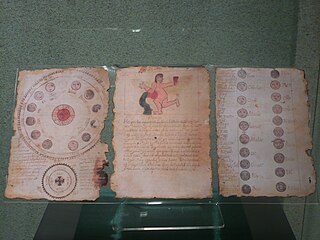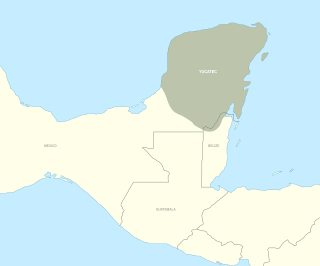Related Research Articles
Mayan or Maya mythology is part of Mesoamerican mythology and comprises all of the Maya tales in which personified forces of nature, deities, and the heroes interacting with these play the main roles. The legends of the era have to be reconstructed from iconography. Other parts of Mayan oral tradition are not considered here.

Ixchel or Ix Chel is the 16th-century name of the aged jaguar Goddess of midwifery and medicine in ancient Maya culture. In a similar parallel, she corresponds, to Toci Yoalticitl "Our Grandmother the Nocturnal Physician", an Aztec earth Goddess inhabiting the sweatbath, and is related to another Aztec Goddess invoked at birth, viz. Cihuacoatl. In Taube's revised Schellhas-Zimmermann classification of codical deities, Ixchel corresponds to the Goddess O.
The Huastec or Téenek are an indigenous people of Mexico, living in the La Huasteca region including the states of Hidalgo, Veracruz, San Luis Potosí and Tamaulipas concentrated along the route of the Pánuco River and along the coast of the Gulf of Mexico.

The Mayan languages form a language family spoken in Mesoamerica, both in the south of Mexico and northern Central America. Mayan languages are spoken by at least six million Maya people, primarily in Guatemala, Mexico, Belize, El Salvador and Honduras. In 1996, Guatemala formally recognized 21 Mayan languages by name, and Mexico recognizes eight within its territory.

The Maya are an ethnolinguistic group of indigenous peoples of Mesoamerica. The ancient Maya civilization was formed by members of this group, and today's Maya are generally descended from people who lived within that historical region. Today they inhabit southern Mexico, Guatemala, Belize, El Salvador, Nicaragua, and Honduras. "Maya" is a modern collective term for the peoples of the region; however, the term was not historically used by the indigenous populations themselves. There was no common sense of identity or political unity among the distinct populations, societies and ethnic groups because they each had their own particular traditions, cultures and historical identity.

The Books of Chilam Balam are handwritten, chiefly 17th and 18th-centuries Maya miscellanies, named after the small Yucatec towns where they were originally kept, and preserving important traditional knowledge in which indigenous Maya and early Spanish traditions have coalesced. They compile knowledge on history, prophecy, religion, ritual, literature, the calendar, astronomy, and medicine. Written in the Yucatec Maya language and using the Latin alphabet, the manuscripts are attributed to a legendary author called Chilam Balam, a chilam being a priest who gives prophecies and balam a common surname meaning ʼjaguarʼ. Some of the texts actually contain prophecies about the coming of the Spaniards to Yucatán while mentioning a chilam Balam as their first author.

The Madrid Codex is one of three surviving pre-Columbian Maya books dating to the Postclassic period of Mesoamerican chronology. A fourth codex, named the Grolier Codex, was discovered in 1965. The Madrid Codex is held by the Museo de América in Madrid and is considered to be the most important piece in its collection. However, the original is not on display due to its fragility; an accurate reproduction is displayed in its stead. At one point in time the codex was split into two pieces, given the names "Codex Troano" and "Codex Cortesianus". In the 1880s, Leon de Rosny, an ethnologist, realised that the two pieces belonged together, and helped combine them into a single text. This text was subsequently brought to Madrid, and given the name "Madrid Codex", which remains its most common name today.

Mesoamerican languages are the languages indigenous to the Mesoamerican cultural area, which covers southern Mexico, all of Guatemala and Belize and parts of Honduras and El Salvador and Nicaragua. The area is characterized by extensive linguistic diversity containing several hundred different languages and seven major language families. Mesoamerica is also an area of high linguistic diffusion in that long-term interaction among speakers of different languages through several millennia has resulted in the convergence of certain linguistic traits across disparate language families. The Mesoamerican sprachbund is commonly referred to as the Mesoamerican Linguistic Area.

Yucatec Maya is a Mayan language spoken in the Yucatán Peninsula, including part of northern Belize. There is also a significant diasporic community of Yucatec Maya speakers in San Francisco, though most Mayan Americans are speakers of other Mayan languages from Guatemala and Chiapas.

Tzotzil is a Maya language spoken by the indigenous Tzotzil Maya people in the Mexican state of Chiapas. Most speakers are bilingual in Spanish as a second language. In Central Chiapas, some primary schools and a secondary school are taught in Tzotzil. Tzeltal is the most closely related language to Tzotzil and together they form a Tzeltalan sub-branch of the Mayan language family. Tzeltal, Tzotzil and Chʼol are the most widely spoken languages in Chiapas besides Spanish.

Maya codices are folding books written by the pre-Columbian Maya civilization in Maya hieroglyphic script on Mesoamerican bark paper. The folding books are the products of professional scribes working under the patronage of deities such as the Tonsured Maize God and the Howler Monkey Gods. The codices have been named for the cities where they eventually settled. The Dresden codex is generally considered the most important of the few that survive.
Mayan Sign Language is a sign language used in Mexico and Guatemala by Mayan communities with unusually high numbers of deaf inhabitants. In some instances, both hearing and deaf members of a village may use the sign language. It is unrelated to the national sign languages of Mexico and Guatemala, as well as to the local spoken Mayan languages and Spanish.

K’uk’ulkan, also spelled Kukulkan, is the serpent deity of Mayan mythology. It is closely related to the deity Qʼuqʼumatz of the Kʼicheʼ people and to Quetzalcoatl of Aztec mythology. Prominent temples to Kukulkan are found at archaeological sites in the Yucatán Peninsula, such as Chichen Itza, Uxmal and Mayapan.
The traditional Maya or Mayan religion of the extant Maya peoples of Guatemala, Belize, western Honduras, and the Tabasco, Chiapas, Quintana Roo, Campeche and Yucatán states of Mexico is part of the wider frame of Mesoamerican religion. As is the case with many other contemporary Mesoamerican religions, it results from centuries of symbiosis with Roman Catholicism. When its pre-Hispanic antecedents are taken into account, however, traditional Maya religion has already existed for more than two and a half millennia as a recognizably distinct phenomenon. Before the advent of Christianity, it was spread over many indigenous kingdoms, all with their own local traditions. Today, it coexists and interacts with pan-Mayan syncretism, the 're-invention of tradition' by the Pan-Maya movement, and Christianity in its various denominations.
The Mesoamerican Long Count calendar is a non-repeating base-20 and base-18 calendar used by several pre-Columbian Mesoamerican cultures, most notably the Maya. For this reason, it is often known as the MayaLong Count calendar. Using a modified vigesimal tally, the Long Count calendar identifies a day by counting the number of days passed since a mythical creation date that corresponds to August 11, 3114 BCE in the proleptic Gregorian calendar. The Long Count calendar was widely used on monuments.
William Edmond Gates was an American Mayanist. Most of his research focused around Mayan language hieroglyphs. He also collected Mesoamerican manuscripts. Gates studied Mayan-based languages like Yucatec Maya, Ch'olti', Huastec and Q'eqchi'. Biographies state that he could speak at least 13 languages. Works and archives related to Gates reside in the collections of Brigham Young University.
Matthew Restall is a historian of Colonial Latin America. He is an ethnohistorian, a Mayanist, a scholar of the conquest, colonization, and the African diaspora in the Americas, and a historian of popular music. Restall has areas of specialization in Yucatán and Mexico, Guatemala, and Belize. He is a member of the New Philology school of colonial Mexican history and the founder of a related school, the New Conquest History. He is currently Edwin Erle Sparks Professor of Latin American History and Anthropology, and Director of Latin American Studies, at the Pennsylvania State University. He is a former president of the American Society for Ethnohistory (2017–18), a former editor of Ethnohistory journal (2007–17), a former senior editor of the Hispanic American Historical Review (2017–22), editor of the book series Latin American Originals, and co-editor of the Cambridge Latin American Studies book series. He also writes books on the history of popular music.

Maya astronomy is the study of the Moon, planets, Milky Way, Sun, and astronomical phenomena by the Precolumbian Maya Civilization of Mesoamerica. The Classic Maya in particular developed some of the most accurate pre-telescope astronomy in the world, aided by their fully developed writing system and their positional numeral system, both of which are fully indigenous to Mesoamerica. The Classic Maya understood many astronomical phenomena: for example, their estimate of the length of the synodic month was more accurate than Ptolemy's, and their calculation of the length of the tropical solar year was more accurate than that of the Spanish when the latter first arrived. Many temples from the Maya architecture have features oriented to celestial events.
The Middle American Research Institute was established at Tulane University in 1924.
References
- 1 2 3 4 "Victoria Bricker // Roger Thayer Stone Center For Latin American Studies at Tulane University". stonecenter.tulane.edu. Retrieved 2015-11-27.
- 1 2 3 4 American Women of Science Since 1900: Essays A-H. Vol.1. ABC-CLIO. 2011-01-01. ISBN 9781598841589.
- 1 2 "Harvey M. Bricker and Victoria R. Bricker". had.aas.org. Retrieved 2015-11-27.
- ↑ "Mayan Languages Collection of Victoria Bricker". Archive of Indigenous Languages of Latin America. Retrieved 2020-02-18.
- ↑ "Victoria R. Bricker Papers". American Philosophical Society. Retrieved 2019-05-31.